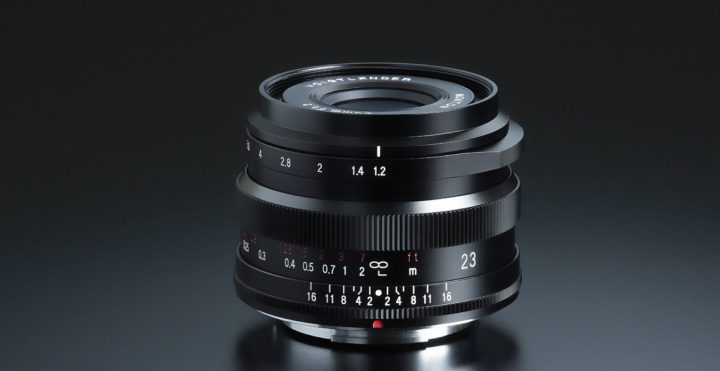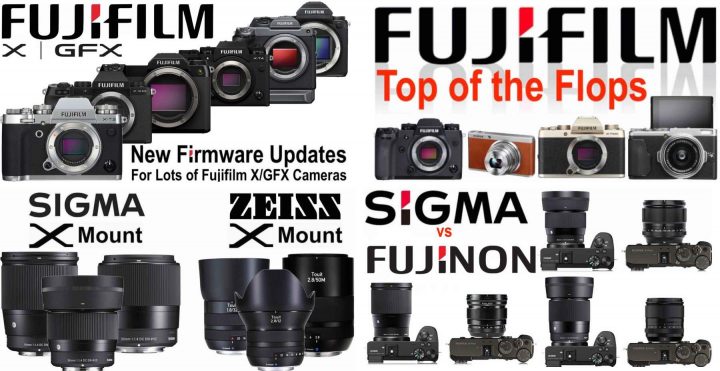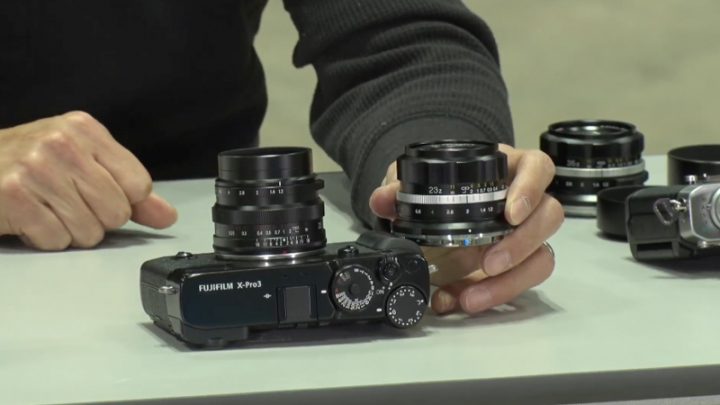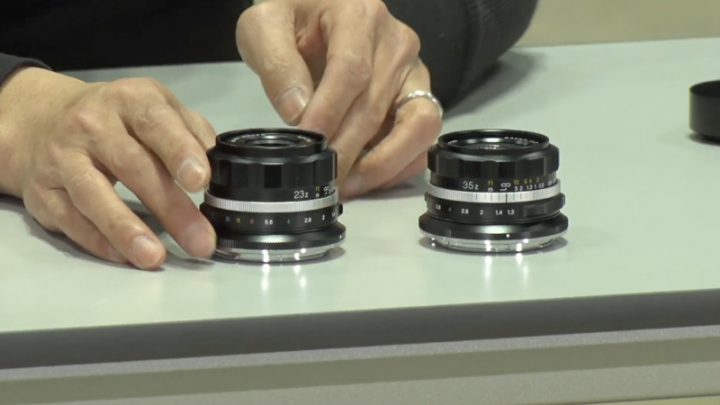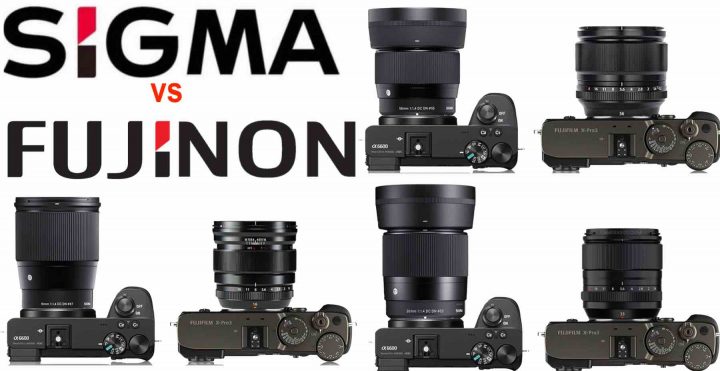Top 10 Fujifilm Camera Flops (and Errors to Avoid in Future) :: Tons of Firmware Updates :: Sigma X Mount Lenses :: Top 10 February Posts
Pre-Orders
- Sigma 16mm f/1.4 DC DN Contemporary: BHphoto / AmazonUS / Adorama / Focuscamera
- Sigma 30mm f/1.4 DC DN Contemporary: BHphoto / AmazonUS / Adorama/ Focuscamera
- Sigma 56mm f/1.4 DC DN Contemporary: BHphoto / AmazonUS / Adorama/ Focuscamera
- Sigma 18-50mm f/2.8 DC DN Contemporary (coming December 2022): BHphoto / AmazonUS / Adorama
Here are the top 10 articles for February.
- Fujifilm Releases Firmware Updates for X-T4, X-T3, X-S10, GFX100S, GFX100 and GFX50S
- Top 10 Fujifilm X Camera Flops and 10 Errors Fujifilm Should Avoid in Future
- BREAKING: Sigma to Launch Three X mount Autofocus Lenses Soon
- BREAKING: Sigma X Mount Lenses to be Announced in February
- Sigma vs Zeiss Touit X Mount: Why Sigma is Not Making the Same Error Zeiss Did
- RUMOR: These are the First Three Sigma X Mount Autofocus Lenses
- Important Notice: Firmware Bug on Fujifilm X/GFX Cameras can Block Access to Files Saved on SD Cards (Fix Coming Shortly)
- Sigma 18-50mmF2.8 for Fujifilm X Currently Under Development
- Fujinon XF23mm f/1.4 R LM WR Reviews, XF70-300 vs XF100-400, Hands-on with XF33mmF1.4 and XF27mmF2.8 R WR and More
- Fujifilm Firmware Updates for X100V, X-E4, X-Pro3, X-T30II, GFX50R, GFX50SII
Also do not miss:
- Sigma Joins Fujifilm X Mount with 16mmF1.4, 30mmF1.4 and 56mmF1.4 AF Lenses – First Looks, Samples and Pre-Orders
- Voigtländer Nokton 23mmF1.2 X Additional Specs and Images
And last but not least:
Follow FujiRumors on Patreon, Facebook, Instagram, RSS-feed, Youtube, Flipboard and Twitter
40K+ Members in Record Time and Growing Faster than Ever!
- Fujifilm Film Simulation Group (100% Fuji Colors Power)
Join Our Owners Groups
Fujifilm X/GFX New Firmware Updates Released and How to Update (Panic-Free) via Camera Remote App
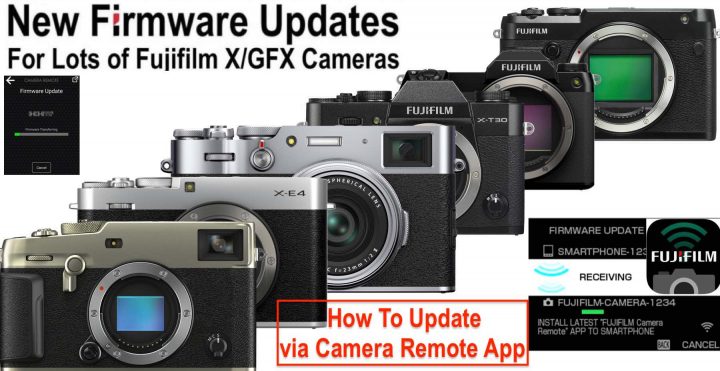
Earlier today Fujifilm has released firmware updates for six Fujifilm X and GFX cameras. You can read all details and access the download links here.
According to a survey we have launched recently, most of you guys prefer to use the good old-fashioned SD-Card way to update your gear.
Personally I’ve switched to updating via camera remote App. The reason is simple: it’s much faster, easier and convenient than updating via SD-Card.
So I definitely recommend to give it a try.
But how does it work?
Well, Fujifilm has given precise instruction on how to do it, but there is one thing that should be mentioned in addition to Fuji’s instruction to avoid updating via App becomes a frustrating experience.
Don’t make the error to connect your phone to the camera the same way you do it when you want to transfer images from your camera to your phone (hence connect via Wifi and fiddle around with the App and Camera to establish a connection).
Nothing of all that is needed.
You can simply leave your camera in live view. Just make sure that it has Bluetooth enabled. Everything will happen automatically and needs just few clicks once you have downloaded the firmware file on your phone.
So the process looks like this:
- make sure Bluetooth is enabled on your camera and on your smartphone
- download the firmware for your camera on your smartphone
- once downloaded, click “update” on your phone first and then “OK” on your camera
- you camera will ask you to connect via WiFi to your phone. Click “Connect” on your phone [in my video below you read “verbinden”, which is the German word for “connect”]
- once connected via Wifi, your phone will start to transfer the firmware file to your camera
- as soon as your camera has received the full file, it will automatically start with the firmware update [you don’t need your phone anymore once the firmware upgrade started on your camera]
- switch off the camera when the camera tells you to do so
It’s very easy, and for your convenience I have made a short video that shows the process down below.
Many are afraid that there could be issues due to network instability or what not. But don’t worry about that. You only need Wifi connection to quickly transfer the firmware file from your phone to the camera. The firmware update itself is performed by your camera independently only once it has received and saved the full firmware file from your smartphone to its own memory. So don’t be afraid of losing connection with the phone during the firmware update itself. Your camera is doing its stuff by its own at that point and the smartphone is not needed anymore.
Remember:
- use a fully charged battery on your camera
- updates are cumulative, so no matter what firmware update you currently have on your camera, you can right away update to the latest version (hence skip intermediate firmware updates)
Voigtländer Nokton 23mmF1.2 X Additional Specs and Images
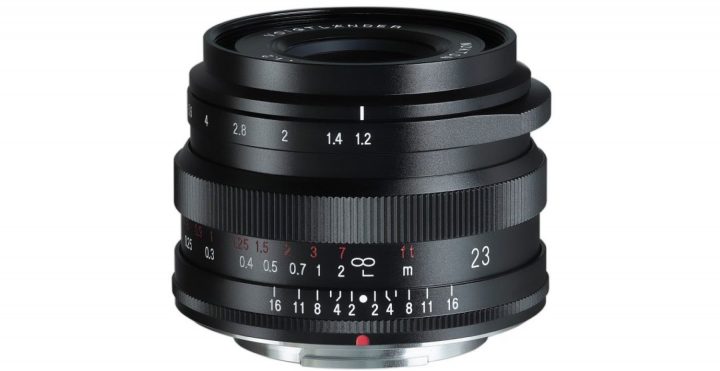
Yesterday we reported how Cosina, in addition to the current Voigländer Nokton 35mm f/1.2 X, is about to launch also the Voigländer Nokton 23mm f/1.2 X.
Now Cosina has published the main specs and a new product image (see above) of this lens at their website in Japanese, which I now report here on FujiRumors machine translated.
A large aperture quasi-wide-angle lens with the latest optics using one double-sided aspherical lens and two abnormal partial dispersion glass. Although it is a compact size, it has excellent resolution from the aperture opening, and large blur due to the large aperture of F1.2 can be obtained.
Just as the 35mm version, also this one has electronic contacts to transfer certain information such as EXIF data.
I love the look of this lens, and actually also of the Voigländer Nokton 35mm f/1.2 X. And although I am tempted to get one, I so far have not treated myself with one, since I’d pay for features (the electronic contacts) that do not work on my Fujifilm X-E3.
This is why I got the much more affordable TTArtisan 23mm f/1.4, which you can see attached to my X-E3 here.
At the bottom of this article you will also find which Fujifilm X cameras are currently supported.
Specs & Supported Cameras
New Voigtländer Nokton 23mm f/1.2 for Fujifilm X Coming Soon
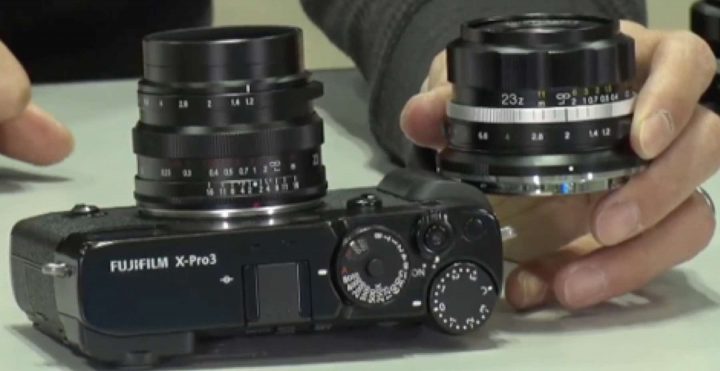
Voigtländer Nokton 23mmF1.2 X
Last year, Cosina launched the Voigtländer Nokton 35mmF1.2 X, with no autofocus, but with electronic contacts which allows for transfer of EXIF data and more (more details at the bottom of the article).
Now Cosina will also launch the Voigtländer Nokton 23mm f/1.2 APS-C lens for Nikon Z and Fujifilm X mount.
Also in this case, there will be electronic contacts but not autofocus.
It’s nice to see that Cosina understands us Fujifilm X shooters (or most of us) better than what Sigma does, and did put the effort to design the X mount version with an aperture ring. I wish the new Sigma X mount trinity would have an aperture ring too. But it’s no dealbreaker in my eyes. I shot my 27mmF2.8 without aperture ring for long and with great joy (but I replaced it now with the new XF27mmF2.8 with aperture ring).
For me, shooting Fujifilm is not only, but also about the experience. This is also the reason why I got the TTArtisan 23mm f/1.4. It’s the look and feel of it, attached to my X-E3 or X-T4, that simply makes me enjoy shooting with it every now and then.
And surely the new Voigtländer NOKTON lenses for Fujifilm X hit the same nerve, with a lovely vintage design and the bonus of electronic contacts that make it an appealing option for X shooters.
Personally, though, the Voigtländer options is not on my radar, because my Fujifilm X-E3 camera is not supported (yet). The full list of supported X series cameras can be found at the very bottom of this article.
- Voigtlander NOKTON 35mm F1.2 X: BHphoto, AmazonUS, Adorama
- TTArtisan 23mm f/1.4: BHphoto / AmazonUS / AmazonDE / Pergear
New from Sigma
- Sigma 16mm f/1.4 DC DN Contemporary: BHphoto / AmazonUS / Adorama / Focuscamera
- Sigma 30mm f/1.4 DC DN Contemporary: BHphoto / AmazonUS / Adorama/ Focuscamera
- Sigma 56mm f/1.4 DC DN Contemporary: BHphoto / AmazonUS / Adorama/ Focuscamera
- Sigma 18-50mm f/2.8 DC DN Contemporary (coming December 2022): BHphoto / AmazonUS / Adorama
via dc-watch and digicame-info.
Follow FujiRumors on Patreon, Facebook, Instagram, RSS-feed, Youtube, Flipboard and Twitter
The Fastest Growing Fujifilm Group
- Fujifilm Film Simulation Group (100% Fuji Colors Power)
Join Our Owners Groups
- Fujifilm GFX User Group
- Fujifilm X-T User Group
- Fujifilm X-S User Group
- Fujifilm X-H User Group
- Fujifilm X-E User Group
- Fujifilm X-Pro User Group
- Fujifilm X100 line Group
Voigtlander NOKTON 35mm F1.2 X – Important information regarding data communication: There are restrictions associated with different camera models.
- Transfer of EXIF data possible – (note * 1) (note * 2)
- Focus magnifier (focus peaking) – possible Distance display possible
- Distance display – possible
- Image stabilization – possible on all models with an image stabilization
- function Parallax compensation – only possible with X-Pro3 Body
Communication compatible models und Firmware (note *3)
- Body Firmware X–H1 v1.10 or later
- X-T4 v1.00 or later
- X-T3 v1.00 or later
- X-T2 v4.10 or later
- X-Pro3 v1.00 or later
- X-S10 v1.00 or later
- X-E4 v1.00 or later
- X-T30 v1.00 or later
Fujifilm Releases Firmware Updates for X-T4, X-T3, X-S10, GFX100S, GFX100 and GFX50S
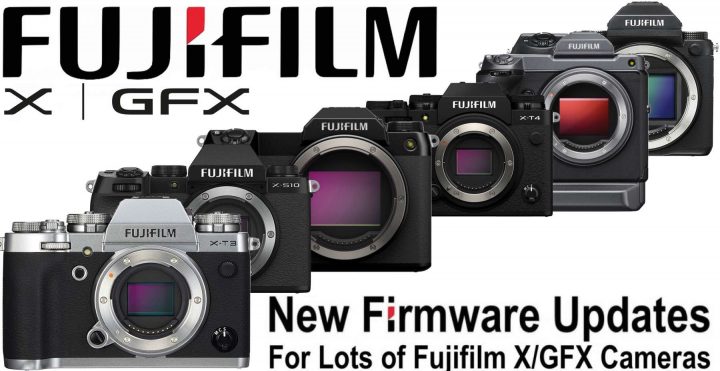
As we reported earlier this month, Fujifilm discovered a bug in twelve of their cameras.
Six cameras got a firmware update to fix the bug today, whereas the rest of the cameras will get it later this month.
You find all the details down below, as well as the download links.
Firmware Updates
Press Release + Download Links
Sigma DC DN vs Fujinon XF Size Comparison
As we told you a few weeks ago, Sigma will announce X mount lenses “soon”. I never gave a date (and hence I never said they would be announced today, Feb.9), but I confirm everything I said so far, hence that they will come “soon” and that Sigma will start their X mount adventure with these three lenses:
- Sigma 16mm f/1.4 DC DN Contemporary
- Sigma 30mm f/1.4 DC DN Contemporary
- Sigma 56mm f/1.4 DC DN Contemporary
Assuming that Sigma will not design completely new lenses, but use the current design and just adapt the mount to make it fit on X series cameras, I have made a couple of comparisons already.
- Compared: Sigma 16mmF1.4 vs Fujinon XF16mmF1.4, Sigma 30mmF1.4 vs XF33mmF1.4 and Sigma 56mmF1.4 vs XF56mmF1.2
- Sigma vs Viltrox X Mount AF Lens Specs and Price Comparison
One spec that is maybe better seen on images rather than expressed in numbers, is the size of the lenses.
So I used the camerasize.com database to compare the future Sigma X mount lenses to their Fujifilm X mount counterparts.
Note that I’ve mounted the Sigma lenses on a Sony A6600 and the Fujinon lenses on an X-Pro3, since that way both lenses have their mount pretty much perfectly aligned. And of course, camerasize has the Sigma lenses with lens hood, but it’s really not a massive effort of imagination to “think away” those lens hoods.
For the full specs comparison, you can click the links below:
- Sigma 16mm f/1.4 DC DN vs Fujinon XF16mm f/1.4 R WR
- Sigma 30mm f/1.4 DC DN vs Fujinon XF33mm f/1.4 R LM WR
- Sigma 56mm f/1.4 DC DN vs Fujinon XF56mm f/1.2 R
Related articles:
- Sigma vs Zeiss Touit X Mount: Why Sigma is Not Making the Same Error Zeiss Did
- Expected Price and Specs of Upcoming Fujifilm X Mount Sigma 16mmF1.4, 30mmF1.4 and 56mmF1.4 DC DN Contemporary
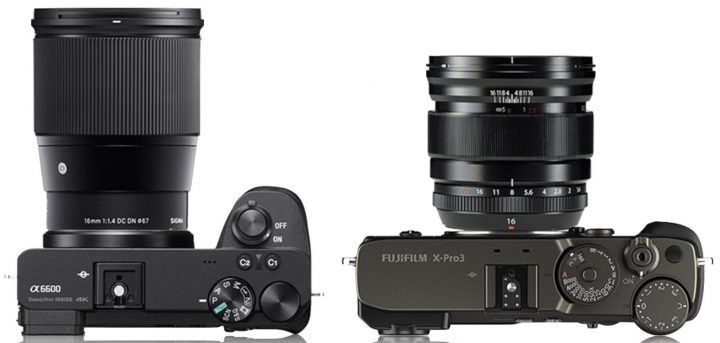
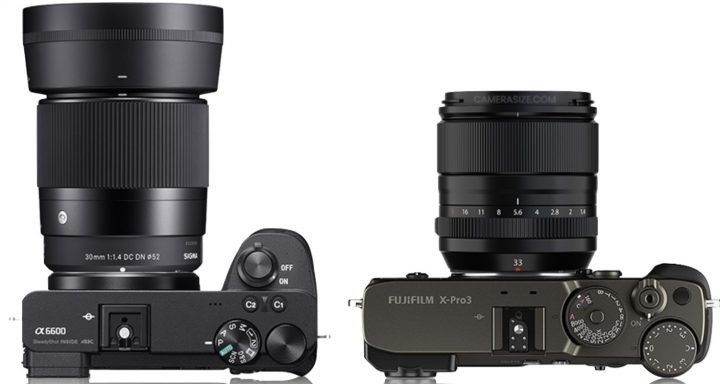
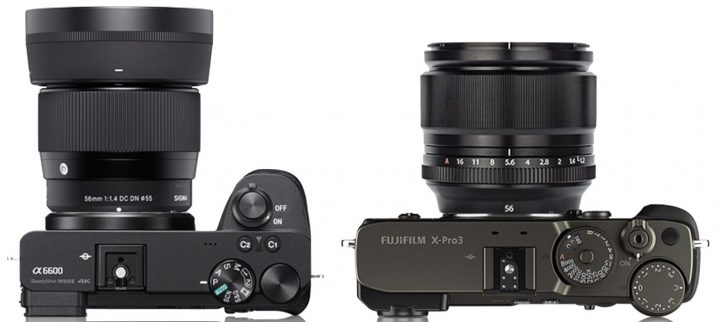
Follow FujiRumors on Patreon, Facebook, Instagram, RSS-feed, Youtube, Flipboard and Twitter
40K+ Members in Record Time and Growing Faster than Ever!
- Fujifilm Film Simulation Group (100% Fuji Colors Power)
Join Our Owners Groups
- Fujifilm GFX User Group
- Fujifilm X-T User Group
- Fujifilm X-S User Group
- Fujifilm X-H User Group
- Fujifilm X-E User Group
- Fujifilm X-Pro User Group
- Fujifilm X100 line Group
Join Our Facebook Pages
Important Notice: Firmware Bug on Fujifilm X/GFX Cameras can Block Access to Files Saved on SD Cards (Fix Coming Shortly)
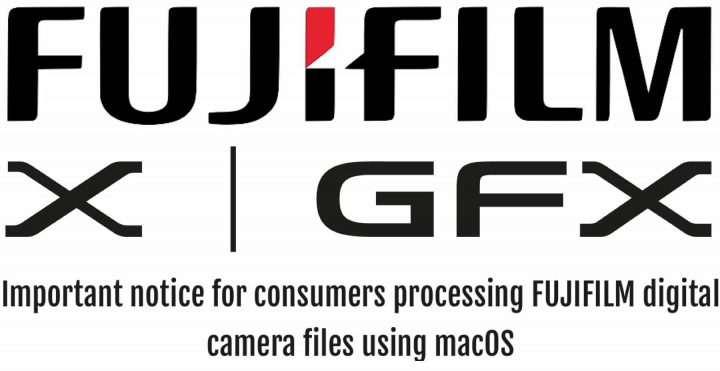
Press Release
Feb.2.2022
FUJIFILM Corporation
FUJIFILM Corporation has identified a firmware incompatibility between specific X and GFX series cameras listed below. This incompatibility can result in macOS users being unable to directly access files if they were initially saved to SDXC memory cards in-camera.
To address this anomaly, Fujifilm is creating a firmware patch, which is expected to be available for free download by X Series and GFX System users soon.
In the interim, please review the following information carefully for further information and recommended next steps.
I. Firmware Incompatibility Overview
Fujifilm X-Pro1 Retrospective – 10 years of Fujifilm X-mount: The Start of X-Trans, Vintage Fun, Film Simulations and More
This month marks the 10th anniversary of the X mount system, so DPRTV takes a fresh look at the Fujifilm X-Pro1, the system’s first camera, to see how it holds up a decade late.
NOTE: we are talking X Mount MILC cameras, not X series cameras in general. The X line started of course with the original Fujifilm X100.
Gosh, what memories came up to me, after all this time.
For example when Jordan highlights how bad the video quality of the X-Pro1 is. True, but when Fujifilm removed an X-Pro1 firmware because of a bug on the video side of things, 99,9999% of X shooters owning an X-Pro1 were like “what, this thing can shoot also video?”
Or all the the glory and struggles related to Fujifilm’s new X-Trans design. Lots of myths and fakes had to be debunked in this regard.
Look, I was always honest to look at the advantages of Bayer vs X-Trans and vice versa, but at the end I am very happy that the Fujifilm X-H2 will have an X-Trans sensor (at least one of the two). And I am not alone, as the vast majority of you guys is happy about this too.
And yes, Kaizen, that’s something the X-Pro1 got lots of. But on the contrary of what many think, still today Fujifilm leads the pack when it comes to updating their cameras. I elaborated it more in depth here.
But most importantly, the joy to use a Fujifilm camera is still the same, also after 10 years. In fact, Chris seems to have loved to shoot the X-Pro1 even more now as opposed to when it came out 10 years ago.
So, with all that said, here is are DPRTV’s impressions after shooting the X-Pro1 again 10 years later.
Little curiosity: I find it cool that Chris took all the pictures using the original XF lens trinity launched along with the X-Pro1.
- he enjoys using the optical viewfinder (the X-Pro1 has a hybrid viewfinder
- great vintage look
- aimed to work best with smaller primes
- great for street shooters
- compact camera with compact primes
- the X-T1 opened the system to lots more people. The whole Fujifilm system grew from there
- X-Pro1 was the first camera using an X-Trans sensor
- thanks to X-Trans Fujifilm could get rid of the aliasing filter, which would have removed some sharpness to the images
- now it is much easier to edit X-Trans files
- X-Trans avoided a lot of the problems with moire for photos
- but at that time, it was hard to work with X-Trans files. Adobe struggled with X-Trans files and 10 years later people still complain about this
- Fujifilm started its reputation for great colors in JPEGs and great details
- the X-Pro1 did not have many film simulations
- in 10 years we have gained so many more film simulations. The latest Fujifilm cameras have even more vintage film simulations like Nostalgic Negative and Classic Chrome, etc
- Chris is impressed but how accurate the optical overlay still is with its frame lines (compensating for parallax)
- not great AF controls. Best solution: single AF with focus and recompose. It’s pretty snappy used this way
- terrible camera for video
- it’s incredible that just 10 years ago Fuji was so bad in video, but now for Jordan Fujifilm cameras are among his favorite cameras to shoot video
- Chris had a lot of fun shooting the X-Pro1 again
- even if it is 10 years old, it still felt quite current in a lot of ways
- X-Pro1 got tons of Kaizen firmware updates
- maybe Fujifilm does not do Kaizen so much anymore [admin note: I disagree, and I elaborated why here]
- Fujifilm has come a long way and now dominates APS-C and MF market
- Fujifilm still holds on on that vintage feel and heritage build up 10 years ago
- Chris didn’t appreciate the X-Pro1 when it came out, but for some reason he now enjoyed it shooting again
- X-Trans files of X-Pro1 still have very interesting character
X-Trans Related Articles
- LOVING X-TRANS: Landslide Victory for Fujifilm X-H2 with X-Trans V vs Bayer in Survey
- Fujifilm X-Trans Vs. Bayer: Pros and Cons of Going Bayer or Sticking with X-Trans Sensor
- Fujifilm X-H2 Coming with New X-Trans Sensor: My Thoughts and Your Vote!
- Debunking Fujifilm X-Trans Myths: Purple Flare, Wormy Artifacts, High ISO Cheating, Waxy Skin Tones & More
- Top 10 Attacks on Fujifilm (That Don’t Make Sense): Full Frame Desires, GFX Facts Distortion, Kaizen Death, X-Trans Flaws, DOF and more
- Fujifilm BAYER vs X-TRANS Blind Test: 88% of Preferences Go To…
Celebrating Fujifilm…
- Top 10 Most Important Fujifilm Digital Cameras of All Time
- Fujifilm X-H2 Announcement in May and Celebrating 10 Years of Fujifilm X Series
- Celebrating 5 Years of Fujifilm GFX Series
- FujiRumors Turns 10 Years Old Today (just as the Fujifilm X Mount)
Long live the glorious Fujifilm X-Pro line.
- Fujifilm X-Pro1: AmazonUS / BHphoto
- Fujifilm X-Pro2: BHphoto / AmazonUS / FocusCamera / Adorama,
- Fujifilm X-Pro3: BHphoto / AmazonUS / Adorama / FocusCamera
Top 10 Most Important Fujifilm Digital Cameras of All Time
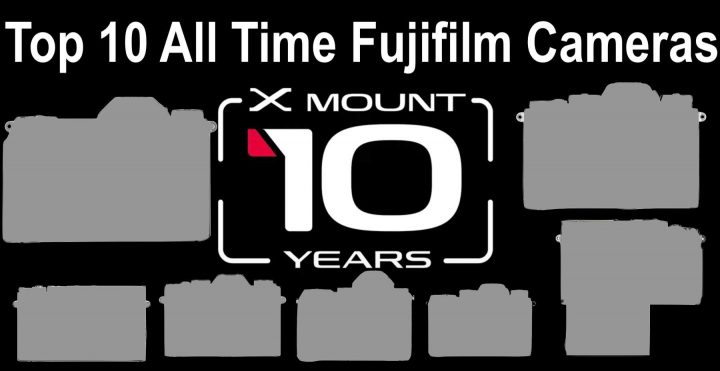
How can I start this article.
Maybe like this.
I was solo hiking through Eastern Europe. In my bag, a tent, food, water, a few clothes. And my DSLR gear.
One morning I woke up very early at the top of the Popluks mountain in Albania, left my tent and enjoyed the sunrise all alone on the mountain peak. It should have been my last day on one of the best kept secrets in Europe, the Albanian Alps. Next stop: a 12 hours long hike all the way to Montenegro through lonely mountains and valleys of rare beatuy.
And I tell you this: when I arrived at my destination, the town of Gusinje in Montenegro, I was exhausted and I promised myself: I need to travel lighter. I need lighter gear.
So I went mirrorless.
Panasonic, Olympus, Sony, you name it, I tried them all. But it became soon clear to me that I was not only looking for lighter gear, but also for gear that I had fun to use.
And exactly in that moment of my photographic journey, 11+ years ago, Fujifilm launched the Fujifilm X series. Then, 10 years ago, the Fujifilm X-Pro1 was announced, introducing the X mount in the photography world.
And that was it. That was exactly what I was looking for.
The rest is history. I fell in love. I needed to share this love. I started FujiRumors.
So I wondered, how can we sum up this long Fujifilm X journey (which is basically just as long as my personal journey with Fujifilm) best?
Well, since Fujifilm is celebrating 10 years of X mount this year, I thought I could make a list of what I consider the top 10 cameras of this Fuji-decade. But, shall it be allowed to me, I will start with the X100, which is technically older than 10 years. But I think you’ll agree it makes sense to add to this list.
Attention: we are not (only) talking about the most successful cameras, but also about what I consider the most important ones, beyond the success they had (or not).
- Fujifilm X100 – the original
That’s the camera that started it all. And it gave us a clear indication on which way Fujifilm would go: great looking cameras with manual controls and overall vintage feel. - Fujifilm X-Pro1
This was Fujifilm’s first mirrorless camera with interchangeable lenses. Iconic. Beautiful. The start of X-mount. - Fujifilm X-T1
If you ask me, my heart, I’d say X-E1 (as I love the X-E series). But that line was never a huge seller. The real first big success for the Fujifilm X mount was the Fujifilm X-T1. It was the first camera that was able to go a bit more mainstream compared to X-Pro1 and X-E1. - Fujifilm X-T10
The X-T10 was a huge hit and helped Fujifilm to break through mid-range market in a way the X-E line could not. A very successful series for Fujifilm, started by X-T10. - Fujifilm X-H1
True, it was not a big success, but it set the base for a platform that will earn lots of success in future. That’s why I put it on the list. Guys, just wait to see what a beast the Fujifilm X-H2 will be, and then you’ll agree with me. Be patient, May isn’t that far anymore. - Fujifilm X-T3
A mega success for Fujifilm that not even the release of the Fujifilm X-T4 could stop. According to my knowledge, Fujifilm’s all time best seller. - Fujifilm X100V
Announced 8 years after the original X100, it was a terrific success for Fujifilm and it brings a much needed redesign of the lens as well as an “invisible” tilt screen. It’s my biggest GAS temptation along with these 2 more Fujifilm items. And please, don’t trigger my GAS further in the comments. I have a marriage to take care of ;) - Fujifilm GFX50S
Enter medium format: Fujifilm’s first digital medium format camera with a sensor about 70% fuller than full frame. Now that we arrived at the Fujifilm GFX100S, which is even smaller than some full frame mirrorless cameras out there, we can say that the GFX50S (hence skipping full frame) was an incredibly smart move by Fujifilm. - Fujifilm GFX100S
It has to be on the list, as it is such a terrific success for Fujifilm. Not even in their best dreams they’d have hoped for as many sales as the GFX100S generated. The only problem: Fujifilm has a hard time producing as many cameras as the market requests, yes, even now, 1 year after its announcement. And please, stop to say nonsense like “it should not have had IBIS” or stuff like that. This nonsense often comes from the same people praising OIS. So aren’t both, OIS and IBIS, serving the very same purpose. And more importantly, can’t you simply turn off both if you don’t like them? - Fujifilm X-Pro3
Arguably the most controversial on the list, as this camera is designed for the niche and therefore was never planed to make massive sales. But here is the thing: while Fujifilm has indeed released the X-S10 and GFX100S with more “mainstream” oriented ergonomics, the Fujifilm X-Pro3 shows that Fujifilm cares also about niche and does not run only after the mainstream. They still want to offer all sorts of different photographic experiences by changing the ergonomics among various camera lines. So don’t panic guys, Fujifilm ain’t dropping retro at all. Whoever creates panic about this, is just out for clickbait. The X-Pro3 is Fuji’s statement for their continuing commitment to retro and vintage controls.
So that’s my list. Feel free to change and modify it as you want in the comments.
- Must Read for X100 Lovers – “Don’t Touch that Camera!” the Story About the Inspiration Behind the Fujifilm X100 Series Design
Follow FujiRumors on Patreon, Facebook, Instagram, RSS-feed, Youtube, Flipboard and Twitter
The Fastest Growing Fujifilm Group
- Fujifilm Film Simulation Group (100% Fuji Colors Power)
Join Our Owners Groups
- Fujifilm GFX User Group
- Fujifilm X-T User Group
- Fujifilm X-S User Group
- Fujifilm X-H User Group
- Fujifilm X-E User Group
- Fujifilm X-Pro User Group
- Fujifilm X100 line Group
Join Our Facebook Pages

